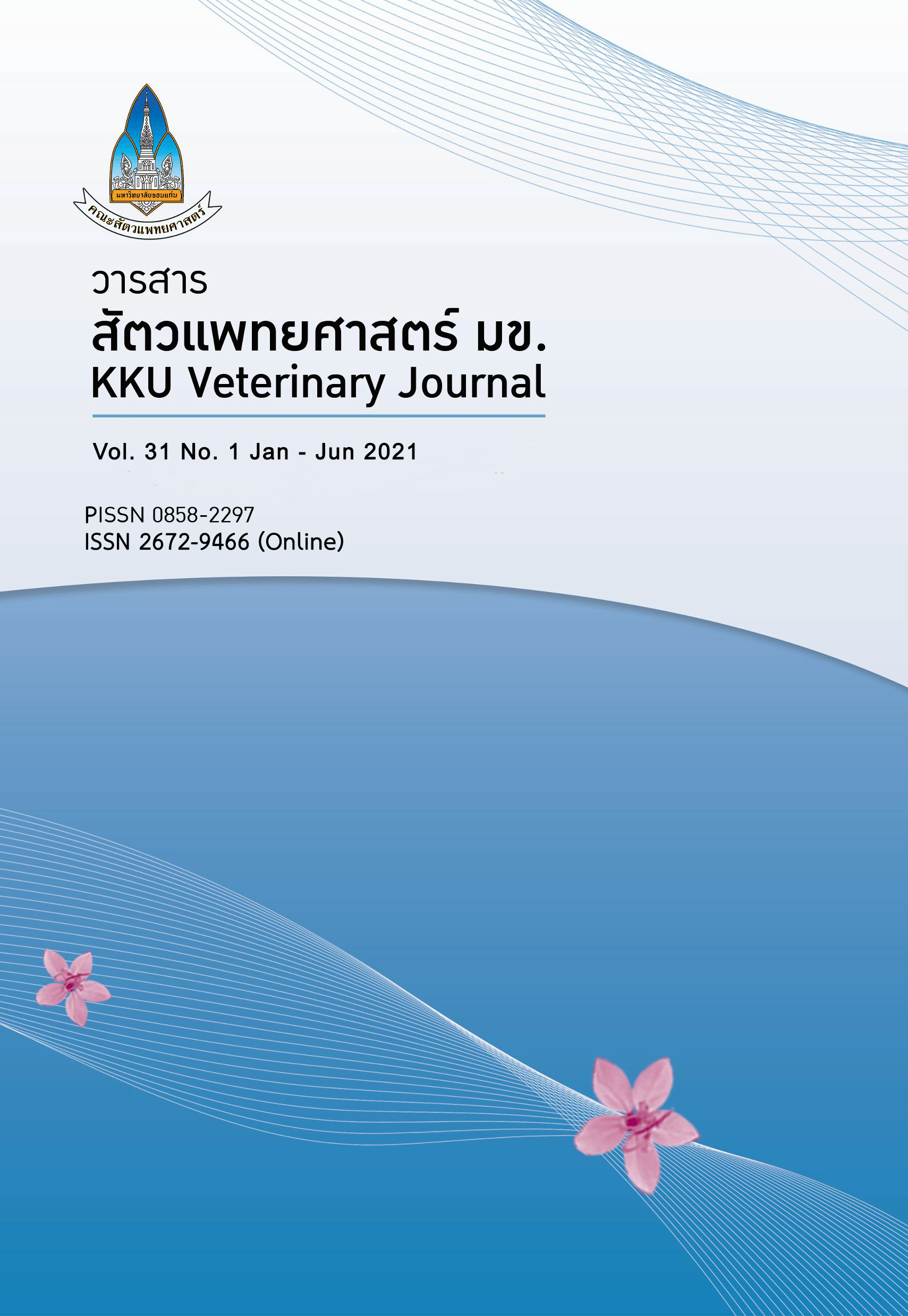Antibiotic Residues in Pork in the Northeast of Thailand
Main Article Content
Abstract
Objective: The purpose of this research was to study the prevalence of antimicrobial residue in pork from different pig farms in the Northeast of Thailand.
Materials and Methods: A total of 469 pork samples were randomly collected from slaughterhouses in 7 provinces of the third and fourth livestock areas during 2017 and 2018. Antibiotic residues in pork were analyzed using the CM® test and group of antibiotic residues was confirmed using the European Six Plate Test method.
Results: Antibiotic residues were found in 16.6% of the total examined pork. The percentage of samples that tested positive differed significantly from area to area. Farm type had no effect on antibiotic residues in pork. Most of the antibiotic residues in pork found in this study were in the group of tetracyclines and penicillins.
Conclusion: Results of this study concluded that different farm sizes or rearing management were not the main factors affecting antimicrobial residues in pork in the Northeastern of Thailand. Antimicrobial residues in pork likely result from individual drug treatment. Therefore, strict management of individual sick pigs in the pre-slaughter period should be an important approach to reducing antimicrobial residues in pork.
Article Details
References
Baptista FM, Alban L, Olsen AM, Petersen JV, Toft N, 2012. Evaluation of the antibacterial residue surveillance programme in Danish pigs using Bayesian methods. Prev Vet Med 106(3-4), 308-314.
Buur J, Baynes R, Smith G, Riviere J, 2006. Use of probabilistic modeling within a physiologically based pharmacokinetic model to predict sulfamethazine residue withdrawal times in edible tissues in swine. Antimicrob Agents Chemother 50(7), 2344-2351.
Chalermchaikit T, Lertworapreecha M, Poonsook K, Lertworapreecha N, Srisanga S, Jotisakulratana K, 2003. "CM-Test" (Clean Meat-Test): The new antimicrobial residue screening test kit in meat. The 11th International Symposium of the World Association of Veterinary Laboratory Diagnosticians and OIE Seminar on Biotechnology, November 9-13;
Choldumrongkul S, 2014. A study on prevalence and usage pattern cause of antimicrobial residues in pork and chicken meat in Songkhla province for preventive sustainable strategy. Thaksin J 17(2), 5-16.
Cochran WG, 1997. Sampling techniques New York: John Wiley & Sons:
Hallenberg GS, Jiwakanon J, Angkititrakul S, Kang-air S, Osbjer K, Lunha K, Sunde M, Järhult JD, Van Boeckel TP, Rich KM, Magnusson U, 2020. Antibiotic use in pig farms at different levels of intensification—farmers’ practices in northeastern Thailand. PLOS ONE 15(12), e0243099.
Katz SE, Brady MS, 2000. Antibiotic residues in food and their significance. Food Biotechnol 14(3), 147-171.
Lekagul A, Tangcharoensathien V, Liverani M, Mills A, Rushton J, Yeung S, 2021. Understanding antibiotic use for pig farming in Thailand: a qualitative study. Antimicrob Resist Infect Control 10(3), 1-11.
Nakarin C, Chartsuphap A, 2010. Antimicrobial resisdues in pork, beef, and chicken in Chaiyaphum province. Bureau of livestock standards and certification, Department of livestock development, Ministry of agriculture and cooperatives, 53(2)-0216(3)-005
Nisha AR, 2008. Antibiotic Residues - A Global Health Hazard. Veterinary World 1(12), 375-377.
Nuangmek A, Rojanasthien S, Yamsakul P, Tadee P, Thamlikitkul V, Tansakul N, Suwan M, Prasertsee T, Chotinun S, Patchanee P, 2021. Perspectives on antimicrobial use in pig and layer farms in Thailand: legislation, policy, regulations and potential. Vet Integr Sci 19(1), 1-21.
Qiu J, Zhao T, Liu Q, He J, He D, Wu G, Li Y, Jiang C, Xu Z, 2016. Residual veterinary antibiotics in pig excreta after oral administration of sulfonamides. Environ Geochem Health 38(2), 549-556.
Rakotoharinome M, Pognon D, Randriamparany T, Ming JC, Idoumbin JP, Cardinale E, Porphyre V, 2014. Prevalence of antimicrobial residues in pork meat in Madagascar. Trop Anim Health Prod 46(1), 49-55.
Srisung P, Nakeesang A, 2007. Surveillance of antimicrobial residues on chicken meat and pork by micro assay method in the northern part of Thailand. Bureau of livestock standards and certification, Department of livestock development, Ministry of agriculture and cooperatives, 50(2)-0312-123.
Strom G, Halje M, Karlsson D, Jiwakanon J, Pringle M, Fernstrom LL, Magnusson U, 2017. Antimicrobial use and antimicrobial susceptibility in Escherichia coli on small- and medium-scale pig farms in north-eastern Thailand. Antimicrob Resist Infect Control 6(75), 1-9.
Strom G, Jiwakanon J, Angkititrakul S, Kang-air S, Osbjer K, Lunha K, Sunde M, Järhult JD, Van Boeckel TP, Rich KM, Magnusson U, 2020. Antibiotic use in pig farms at different levels of intensification-Farmers' practices in northeastern Thailand. PLOS ONE 15(12), 1-14.
Thanapongtharm W, Linard C, Chinson P, Kasemsuwan S, Visser M, Gaughan AE, Epprech M, Robinson TP, Gilbert M, 2016. Spatial analysis and characteristics of pig farming in Thailand. BMC Vet Res 12(218), 1-15.
Van Boeckel TP, Brower C, Gilbert M, Grenfell BT, Levin SA, Robinson TP, Teillant A, Laxminarayan R, 2015. Global trends in antimicrobial use in food animals. Proceedings of the National Academy of Sciences 112(18), 5649-5654.


